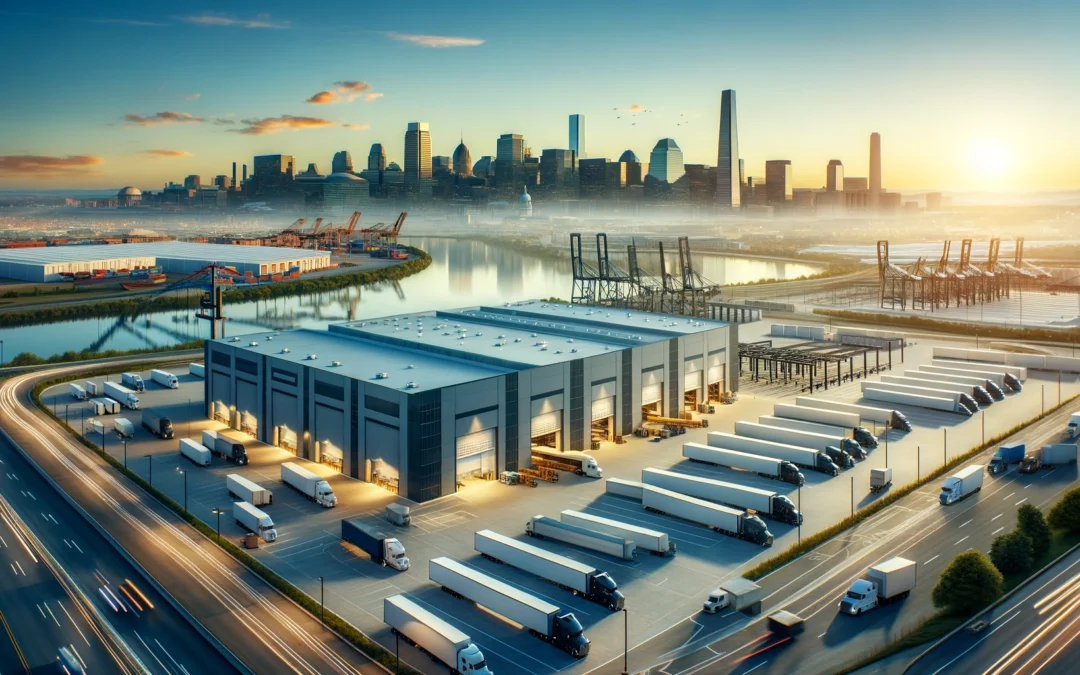The industrial real estate market in the Washington DC and Baltimore region is alive with potential, presenting investors and developers with unique growth opportunities. If you’re eyeing industrial properties in this area, understanding the financing landscape is crucial to making the most of your investments. Let’s dive into the opportunities available, and why now could be the ideal time to seize them. First we’ll go over four reasons the DMV is a great spot for industrial financing. Then, we’ll look at the state of the market. Finally, we’ll break down a few different financing strategies.
4 Reasons the DMV is a Great Industrial Market
1. Regional Demand is Boosting Market Potential
This region’s strategic location near key transportation hubs like the Port of Baltimore and extensive highway networks make it a prime target for logistics and distribution facilities. E-commerce growth, reshoring trends, and supply chain realignment have further boosted demand for warehouses, fulfillment centers, and specialized manufacturing plants. As a result, financing opportunities have expanded, as lenders recognize the growth potential in meeting these regional logistics needs.
2. Favorable Loan Terms for Strategic Locations
Washington DC and Baltimore enjoy favorable lender sentiment due to their central positioning along the East Coast corridor and proximity to government agencies. Expect more attractive financing terms for fully leased properties, strategically positioned near these logistics hubs. Higher loan-to-value ratios, competitive interest rates, and longer amortization periods are becoming the norm.
3. Supporting Sustainability and Adaptive Reuse Projects
Sustainability is a high priority here, with many developers seeking energy-efficient buildings that meet LEED or WELL standards. Adaptive reuse of existing structures is also gaining traction, especially for historically significant buildings near urban cores. Investors who prioritize these factors can find supportive lenders, eager to finance environmentally responsible and adaptable projects.
4. Capitalizing on Growth Zones
Emerging industrial hubs like Northern Virginia, the I-270 corridor, and regions closer to the Port of Baltimore offer significant opportunities for developers seeking higher yields. These areas have strong industrial growth potential due to their access to major transportation routes, and lenders increasingly recognize this. This makes financing available for acquisition and development in secondary markets surrounding Washington DC and Baltimore.
Washington DC Market Analysis
The Washington DC industrial real estate market presents opportunities and challenges for investors. Despite an uptick in vacancy rates, demand remains strong for strategically located properties catering to logistics and last-mile distribution. In Q1 2024, the metro area’s vacancy rates stabilized due to increased leasing activity and strategic absorption of new inventory. Current trends reveal an appetite for state-of-the-art facilities with proximity to major transportation routes, emphasizing the importance of modernization in securing tenants. Additionally, the region’s government sector presence provides stability to the market, with federal contractors often seeking secure warehousing close to the capital.
Baltimore Market Analysis
Baltimore’s industrial market is buoyed by its prime location near the Port of Baltimore, an essential hub for East Coast commerce. The market was undoubtably affected by the tragic collapse of the Key Bridge, however it is showing remarkable resiliency. Although certain submarkets experienced a dip in occupancy, demand for modern distribution facilities remains robust, especially along the I-95 corridor. Average asking rents remain elevated as a result, highlighting the shift toward high-spec warehousing. Market absorption is primarily driven by new lease signings and expansion within existing buildings.
Financing Opportunities
Tailored Financing: Banks and other financial institutions are responding to the market’s mixed performance by offering flexible financing structures tailored to individual needs. Mezzanine financing, bridge loans, and government-backed programs (such as SBA 504 loans) are gaining traction due to their adaptability.
Sustainability and Retrofitting: Properties prioritizing energy efficiency, LEED certification, and adaptive reuse are attracting better loan terms. These facilities are in line with lenders’ focus on long-term asset value and appeal to tenants seeking environmentally responsible spaces.
Alternative Lenders: Private equity firms and specialized real estate funds are increasingly entering the market, offering competitive terms for properties that fit their investment strategies.
Conclusion
Despite the challenges posed by inflation and stubborn interest rates, the Washington DC and Baltimore industrial markets remain attractive. Proximity to key logistics hubs and federal institutions, combined with innovative financing, can lead to significant returns for well-positioned investments. By understanding these market dynamics and adapting financing strategies, investors can secure advantageous terms and expand their industrial portfolios.
If you are interested in a free broker opinion of value or just learning more about investing in commercial real estate in Maryland, Virginia, or Washington DC, please contact us. Avenue Real Estate is a leading full service commercial brokerage in the Baltimore and Washington DC areas and we would love to help you explore your options and make informed decisions about commercial real estate investments.

